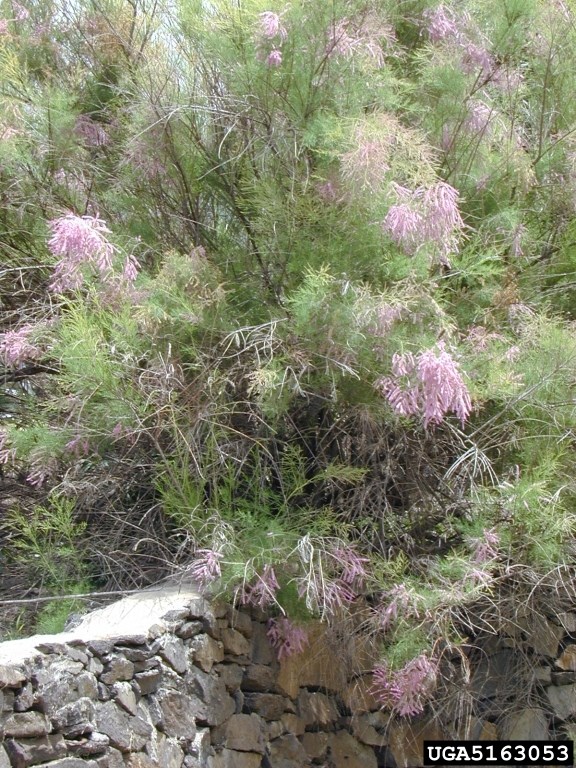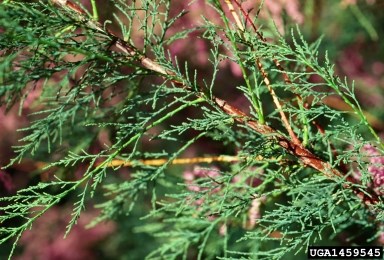
USDA APHIS Archives, www.forestryimages.org Invasive Plant Species: TamariskTamarisk (Tamarix species), also known as salt cedar, is a tall tree with feathery green or blue-green foliage. In New Mexico, tamarisk is the arch-enemy invasive species, the equivalent of our buffelgrass. It is listed as a noxious weed there, as it is in Montana, South Dakota, Texas, and Wyoming. In Arizona, however, removal of mature trees is controversial, in part because it has become a favored nesting site for the endangered Southwestern Willow Flycatcher (Empidonax traillii extimus). How did it get here?Tamarisk may have been introduced in our area for erosion control. It has also been planted as an ornamental tree and for windbreaks. It propagates prolifically by seeds that frequently travel by wind or water. It also reproduces vegetatively; broken plant parts, even tiny leaf-scales, can take root and start new plants. What is the threat?Tamarisk is a thirsty plant with a high evapotranspiration rate, taking lots of water and releasing it into the air. It competes with native plants and can displace riparian habitat. Other than mature trees serving as nesting sites for the Southwestern Willow Flycatcher, it contributes little food or other benefits to native animals. In Saguaro National Park tamarisk is under control, but in other western states, it has caused serious damage. It grows fast and forms thick stands creating large areas of dense shade. This shade discourages native seedlings, from trees to grasses, decreasing the diversity of plants and animals in the ecosystem. It increases fire frequency, changes streambed hydrology, lowers water tables, and increases soil salinity. Several other National Parks such as Grand Canyon, Canyonlands, and Lake Mead National Recreation Area have significant tamarisk infestations that threaten the natural resources and impact recreation. Management goals and strategiesOur goal is to eradicate tamarisk in the Park. It is actively being managed by conducting surveys and removing any individuals we find. We use both manual and chemical controls. Small seedlings are pulled by hand. Plants too large to hand pull are removed by digging out the roots. Mature trees are cut down and herbicide is applied to the trunk to prevent regrowth. The salt cedar leaf beetle (Diorhabda elongata) has been used as a biological control in other states with astonishing success. It has denuded areas previously infested with tamarisk, necessitating active restoration. The beetle has not used in Arizona out of concern for the Southwestern Willow Flycatcher. However, the beetle has spread, bird habitat has been threatened, and the risk of unanticipated consequences has led to calls to reduce use of the beetle, a story nicely captured in this Scientific American article. Progress to datePark biologists thought that tamarisk had been eradicated until 2006, when a 100-year flood event brought seeds and plant parts into the Rincon Creek area that resulted in thousands of seedlings. Park biologists became very concerned because they were not aware of any tamarisk trees in the drainages that feed into the Rincon Creek watershed. If one or two unknown trees could cause this infestation, what would happen if we ignored these seedlings? Faced with thousands of seedlings and the possibility of disaster, the Park applied for and received grant funding for tamarisk survey and removal in all the drainages in the Park that have potential habitat for tamarisk. Crews search for and remove seedlings and trees to bring tamarisk back under control. Survey crews have also found a few mature trees in previously unmonitored washes. Active management is ongoing. Please read ourTamarisk Resource Brief summarizing the work we have done to help eradicate tamarisk from the Park. Tamarisk can propagate both upstream and downstream, by wind as well as water. It is paramount that the Park and private land owners in the Rincon Creek watershed collaborate to remove tamarisk. 
USDA APHIS Archives, www.forestryimages.org How to Identify TamariskTamarisk species are large shrubs or trees with a feathery appearance. Depending on the species, they may be 15 to 50 feet tall when mature and some are deciduous in the winter. Up close, the feathery branches resemble cedars or junipers, with tiny triangular, scale-like leaves on fine twigs. The flowers appear in spikes and are often pink or pale pink, although some are creamy white. How you can helpIf you'd like to volunteer to help survey and remove tamarisk in the Park, e-mail us at sagu_invasive@nps.gov.Don't plant tamarisk. Tamarisk is not yet listed in the Federal or Arizona State noxious weed lists, so it may still be available in nurseries here. Let the nursery management know about your concern for use of this invasive plant in our area. Good alternative trees for your yard include desert willow (Chilopsis linearis) and desert ironwood (Olneya tesota).Remove tamarisk from your yard. Tamarisk seedlings can easily be removed from your yard by digging, but the effort increases with the size of the tree, so don't wait until next season. If you think you may have tamarisk on your property and would like someone from the Park to confirm it, please send a picture to sagu_invasive@nps.gov. |
Last updated: May 6, 2025
